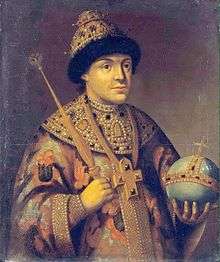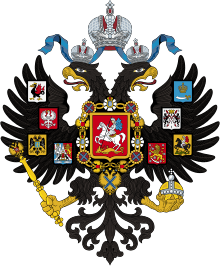Feodor III of Russia
Feodor III Alexeyevich (in Russian: Фёдор III Алексеевич) or Fyodor III Alekseevich (9 June 1661 – 7 May 1682) was the Tsar of Russia between 1676 and 1682.
| Feodor III | |||||
|---|---|---|---|---|---|
 | |||||
| Tsar of Russia | |||||
| Reign | 8 February (29 January O.S.) 1676 – 7 May 1682 | ||||
| Coronation | 18 June 1676 | ||||
| Predecessor | Alexis | ||||
| Successor | Peter I and Ivan V | ||||
| Born | 9 June 1661 Moscow | ||||
| Died | 7 May 1682 (aged 20) Moscow | ||||
| Burial | Archangel Cathedral | ||||
| Consort | Agafiya Semyonovna Grushetskaya
( m. 1680; died 1681)Marfa Apraxina
( m. 1682) | ||||
| |||||
| House | Romanov | ||||
| Father | Alexis I | ||||
| Mother | Maria Ilyinichna Miloslavskaya | ||||
| Religion | Eastern Orthodox | ||||
Life
Born in Moscow, Fyodor, as the eldest surviving son of Tsar Alexis and Maria Miloslavskaya, succeeded his father on the throne in 1676 at the age of fifteen. He had a fine intellect and a noble disposition; he had received an excellent education at the hands of Simeon Polotsky, the most learned Slavonic monk of the day. He knew Polish and even possessed the unusual accomplishment of Latin. He had been disabled from birth, however, horribly disfigured and half paralyzed by a mysterious disease, supposed to be scurvy.[1] He spent most of his time with young nobles, Ivan Maksimovich Yazykov and Aleksei Timofeievich Likhachov, who would later introduce Polish ceremonies, court dress, and language to the Russian court.
On 28 July 1680 he married a noblewoman, Agaphia Simeonovna Grushevskaya (1663 – after 14 July 1681), daughter of Simeon Feodorovich Grushevsky and of his wife Maria Ivanovna Zaborovskaya, and assumed the sceptre. His native energy, though crippled, was not crushed by his disabilities. He soon showed himself as a thorough and devoted reformer. The atmosphere of the court ceased to be oppressive, the light of a new liberalism shone, and the severity of the penal laws was considerably mitigated. The Tsar founded the academy of sciences in the Zaikonospassky monastery, where competent professors were to teach everything not expressly forbidden by the Orthodox church - the syllabus included Slavonic, Greek, Latin and Polish.[2]
The Feodorean and the later Petrine reforms differed in that while the former were primarily, though not exclusively, for the benefit of the church, the latter were primarily for the benefit of the state. A household census took place in 1678.[3] The most notable reform of Feodor III, made at the suggestion of Vasily Galitzine, involved the abolition in 1682 of the system of mestnichestvo, or "place priority", which had paralyzed the whole civil and military administration of Muscovy for generations. Henceforth all appointments to the civil and military services were to be determined by merit and by the will of the sovereign,[2] while pedigree (nobility) books were to be destroyed.
Family
Fyodor's first consort, Agaphia Simeonovna Grushevskaya, shared his progressive views. She was the first to advocate beard-shaving.[2] On 11 July 1681, the Tsaritsa gave birth to her son, Tsarevich Ilya Fyodorovich, the expected heir to the throne. Agaphia died as a consequence of the childbirth three days later, on 14 July, and seven days later, on 21 July, the ten-days-old Tsarevich also died.
Seven months later, on 24 February 1682 Fyodor married a second time Marfa Apraksina (1667–1716), daughter of Matvei Vasilievich Apraksin and wife Domna Bogdanovna Lovchikova. Feodor died three months after his new wedding, on 7 May, without surviving issue. The news of his death sparked the Moscow Uprising of 1682.
Notes
- "Feodor III, Tsar of All Russia". Unofficial Royalty. Retrieved 2020-05-16.
- Chisholm 1911.
-
Moon, David (2014) [1999]. "1: Population". The Russian Peasantry 1600-1930: The World the Peasants Made (revised ed.). London: Routledge. p. 20. ISBN 9781317895190. Retrieved 2019-01-27.
The main sources for the population of the Russian state in the two centuries or so before 1897 are the ten poll tax censuses or revisions (revizii) held between 1719-21 and 1857-58 and the household tax census of 1678.
References
| Wikimedia Commons has media related to Feodor III of Russia. |

External links
- Romanovs. The second film. Feodor III, Sophia Alekseyevna; Ivan V; – Historical reconstruction "The Romanovs". StarMedia. Babich-Design(Russia, 2013)
| Regnal titles | ||
|---|---|---|
| Preceded by Alexis |
Tsar of Russia 1676–1682 |
Succeeded by Peter I and Ivan V |
.svg.png)
.svg.png)
